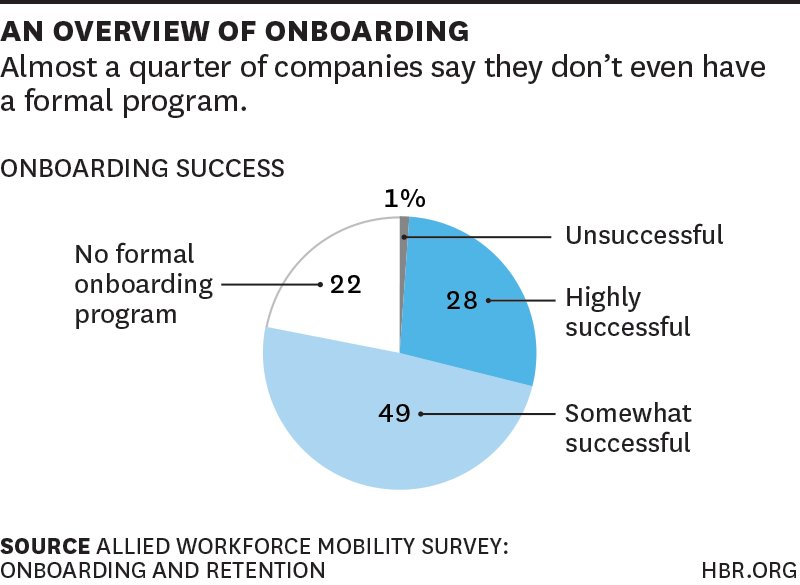What is Remote Onboarding?
Remote onboarding or a virtual onboarding process aims at blending remote employees into your company using virtual means. The process involves activities that help new hires understand the company’s goals, products, work culture, training, meet peers and cross-functional teams, etc.
Importance of Remote Onboarding
A solid, seamless remote onboarding process is important as it directly impacts the integration of a new hire into the company and its work culture. As we spell out the entire process of virtual onboarding here, it may look like a lot of work. Nevertheless, it’s worth the effort.
Not cultivating a streamlined remote onboarding process is reported to cost in many ways. Almost 1 in every 2 HRs in a BambooHR survey taken by over 1000+ members agree that over $10,000 is squandered due to inefficient onboarding. Moreover, Gallup too found the cost of replacing a worker ranges between 90% – 200%. With an ineffective onboarding experience leading to higher worker attrition rates, it’s crucial to effectively onboard an employee.
Furthermore, effective onboarding impacts 3 aspects of your workforce:
- Employee engagement: Employee engagement is not limited to keeping your workers busy with tasks. Nor is it just about the “Fun Fridays” you organize for them. Employee engagement is a qualitative measure of the passion and excitement employees have for the product and the company’s mission. Highly engaged employees are more bound to the organization’s goals. A good onboarding experience is known to increase employee engagement by 18 times.
- Employee performance: You can measure employee performance by analyzing the quality, effectiveness, and speed at which employees complete their tasks. Bamboo HR found employee performance to surge by 38% if employees experience good onboarding. For your remote employees, it is important to create a good onboarding experience that increases their confidence in your company’s mission. This, in turn, impacts employee performance.
- Employee retention: An effective virtual onboarding creates an impressive first impression. Close to 60% of remote employees who experience a great remote onboarding process are likely to stay with the company after 3 years. Moreover, new hire retention is found to decrease by 82% when the onboarding experience instills a good employee-management relationship.
Remote Onboarding Process
Now that we have established the importance of a seamless remote onboarding process, let us dive into the nitty-gritty details of how to build an effective one.
STAGE #1: PRE-BOARDING
Virtual onboarding or in-person, your new hire needs a seamless process between contract signing and logging in on the first day.
Since they will be working remotely, a new hire will require unperturbed access to training modules, email accounts, company wikis, etc. More importantly, it is vital that you send them the necessary hardware and devices to work without any apprehension.
Some companies offer goodies such as bags, t-shirts, mugs, caps to create an identity experience.
Onboarding, whether remote or in-person, aims at easing new hires into your company. A good pre-boarding experience warms up your employee. Preboarding a remote employee removes all friction for a smooth induction into your company.
STAGE #2: PAPERWORK
Your new talent needs to work through some paperwork before clocking in on the first day. Over the week that leads up to the first day, send their offer letter. The offer letter should communicate their responsibilities, timings, official policies, leave policies, etc.
Secondly, forward all legal, tax, and compliance-related paperwork.
Hiring remote employees and contractors in another country requires you to create local entities in the corresponding region.
This presents you with a mountain of challenges.
You’ll need to:
- Generate locally compliant contracts.
- Navigate local labor laws.
- Identify health benefits according to the employee’s country.
If the above is incorrectly addressed, you may face the wrath of local authorities who can push criminal charges against your business.
This where you can choose Multiplier to help. With our local entities in over 50 countries, you can trust us to help you hire full-time employees overseas.
Thirdly, set up their payroll.
Finally, provide resources to help them fully understand the medical and miscellaneous benefits you offer.
STAGE #3: ESTABLISH COMMUNICATION PREFERENCES AND SECURITY OBLIGATIONS
The third step in your remote onboarding process should help your new hire understand the best practices to engage in while they communicate with their peers and higher-ups.
Provide crystal clear steps on setting up:
- Company email account
- Group messaging tool
- Video conferencing
Provide details about the do’s and don’ts of communicating with their peers in the employee handbook.
Next, arrange a remote meeting for your new hire with the IT department. Remote employees need to be aware of the security standards in your company.
The IT department should train them on using appropriate file-sharing applications, cloud backup software, password management, data encryption tools, etc.
STAGE #4 ORIENTATION, INTRODUCTION, & TRAINING
During their orientation, new hires are usually excited and thrilled. However, do note that this excitement is also mixed in with some nervousness and confusion. When working in-house, a peek into a neighbouring cabin is good enough to start a casual conversation and maintain their high spirits.
Unfortunately, it isn’t that straightforward for a remote employee. Remote working is known to cause isolation and loneliness. It is your responsibility to ensure your new hire’s first day isn’t plagued by these factors.
Here are 3 steps towards a successful orientation that you can implement in your remote onboarding process:
Assign a peer mentor: Warming up your new hire by assigning a mentor or a peer buddy can alleviate a great deal of stress off your shoulders and your new hire’s. A peer mentor can assist in acclimating your new hire to their role and the organization.
It would do wonders if the mentor is on the same team and carries out similar responsibilities. Your new hire can shadow the mentor, ask questions, and get absolute answers to various questions.
By making themselves available, the peer mentor can leave a lasting impression of your organization being a worker-friendly environment. Moreover, it helps higher management keep tabs on how the new hire is processing the environment.
- Virtual introductions: When working in-office, new hires are introduced to the team during a stand up or over a team lunch. However, remote employees cannot get this indulgence. Hence, while onboarding remote employees, schedule a virtual happy hour or a coffee break in your team’s calendar. During this session, you could go old school and prompt team members to introduce themselves to the new hire. Otherwise, you could avail of socializing platforms and organize a game session to slice the ice.
- Craft engaging virtual training sessions: While working in-house, group training sessions can easily turn into a highly collaborative discussion. With experienced team members taking charge of these sessions, there is little chance of miscommunication. In-house training sessions are usually made up of active discussions, ice-breakers, live demos, etc.
In contrast, a virtual training session needs meticulous planning to infuse fun and collaboration. In most companies, virtual training is pre-recorded. Sometimes, new hires are given self-paced training material or wikis to learn about the organization.
Your virtual onboarding process must include a diligently planned training session. Design interactive training courses that gamify the content into quizzes, etc. Pre-record product demos to explain product features through video. More importantly, track your new hire’s progress after each training session.
STAGE #5 ROLL OUT THE RESPONSIBILITIES
As the days go by, an effective virtual onboarding process is sure to seamlessly transform your new hire into a motivated employee. They would be fully aware of their objectives, the work culture, the etiquette, etc.
Ideally, by the end of the second week, you could usher your young Turk to deploy their skills.
While onboarding remote workers, it is important to clearly communicate goals, expectations and priorities to your employee. Miscommunication can cause unneeded anxiety and working remotely doesn’t help as well.
Create a task tracker for your employee to understand your new hire’s scope of work. The tracker must communicate the responsibilities, the deadline, and priorities.
To ward off any isolation creeping in, create opportunities for your remote new hire to collaborate with a team member. Collaboration happens organically in an office setting. However, remote working dampens such instances.
Your virtual onboarding program should ensure that your new hire is set up to collaborate on tasks even if their job role doesn’t include any. In such cases, even shadowing tasks of a cross-functional team counts as a collaboration opportunity.
Remember, your employee still needs guidance with many tasks. Hence, training should continue. With an effective onboarding process in place, you can be confident that they can carry out tasks on their own and when in doubt they will know whom to reach and how.
Onboarding Checklist for Remote Employees
As company cultures number in the 1000s, it is impossible to develop a one size fits all remote onboarding solution. A seamless, friendly, inclusive onboarding is essential as it affects the first impression of your organization. And as an employer, it is crucial to make your talent feel welcomed.
At Multiplier, remote onboarding is a breeze. At the time of writing, 100% of our employees are remote. Feel free to get inspired with a few steps we follow:
- A warm message: An in-house onboarding allows you to take your new hire all around your office. However, remote onboarding lacks this luxury. Collect details like past experiences, academic background, hobbies, etc. from your new hire. Craft a warm welcoming message and send it across the organization to introduce them.
- People first, paper next: Onboarding at Multiplier is more about the people and our work culture. Employees commence their virtual onboarding by setting up introductory calls with their peers and members from other cross-functional teams. They are also ushered through company wikis that help them understand the communication process, values, etc.
- Employee engagement: Also, remote onboarding need not be just about intro sessions and sermons on work culture. Here, employees spend a lot of time in the virtual world. This leads to digital fatigue. Multiplier adds a twist by investing in socializing platforms such as Let’s Dive. Our intranet sites hold case studies on how Multiplier has impacted big and small companies and the lives of their isolated employees. This instills a sense of purpose in our employees. We help them resonate with our mission.
- Inculcating competitor intelligence: Does your company maintain an internal document or a Wiki that contains all the ammo for your new hires to hit the ground running after their onboarding? Virtual onboarding, unlike in-house means, lacks a real trainer. With a Wiki, your new hires will have one stop to gather intelligence on your products, services competitors, case studies, etc.
- Roll out the paperwork: Once your new hires feel that your company is all about the people, dole out the documents.
- Security obligations: A remote employee is more vulnerable to security breaches than one working in-house. It would be in your best interest to tell your new hire to fulfil all security obligations before they start their tasks. Some examples include setting up 2-factor authentications, setting up their email accounts, etc.
- Learning & Development: A crucial part of remote onboarding is getting your new hire wiser about your industry. They need to get access to the latest happenings in the industry.
- Weekly follow-ups: Onboarding, in-house or remote, isn’t a one-day thing like an orientation. The process strives to settle your new hires into the company. Follow up every week. Understand how they feel. Empathy is key.
Remote Onboarding Best Practices
¾ employees want mentor-assisted on-the-job training
While onboarding remote employees, most companies provide wikis and SOPs for new hires to learn about the company, the industry, and their goals. Although this tests their initiative to learn, it drowns them with information.
This overwhelming amount of information causes more anxiety and makes them feel at loss.
Hence, you must assign a peer buddy or a mentor to guide your new hire. Virtual onboarding is a lonely thing most often. A mentor can help your new hire speedily integrate with the company.
Set the right expectations
Perceptions of being an unsupportive boss, unexpected responsibilities, unrealistic expectations are some negative feelings that can emanate from a negative onboarding experience.
A virtual onboarding is more prone to miscommunication than an in-house one.
When you err in communication, it sends a lot of wrong signals. An unplanned remote onboarding can easily instill the wrong expectations.
Some best practices to set clear expectations are communicating job descriptions accurately, recognizing a job well done, and being a motivating manager.
An Exciting and Engaging Experience
Onboarding a remote employee may lack the in-house ice-breakers such as hometown map, two truths and a lie, hangman, etc. You may need to invest in video conferencing platforms that have a bunch of games and activities to boost your new hire’s morale and enthusiasm.
However, these investments are worth it. The best remote onboarding experience is one that engages your employees from the get-go. Apart from walking them through your expectations and their responsibilities, new hires must be instilled with a purpose.
Help them make your company’s mission their life’s purpose. Enable them to absorb the company’s values by handing out employee handbooks, walking them through company policies, assigning a buddy mentor, etc.
Onboarding Remote Employees with Multiplier
Building an effective remote onboarding process isn’t among the top priorities of many companies right now. However, with the increasing competition to hire good remote talent, paying due diligence to your remote onboarding process becomes essential.
Bad onboarding shoots up employee turnover rates. Consequently, you will have to be in constant hiring mode. With the soaring competition to find new talent, you will likely reach exorbitant monetary and opportunity costs.
Here is where Multiplier can help you. By reducing virtual onboarding to less intense activity, Multiplier functions as an effective remote onboarding software for small and large businesses alike.
Multiplier’s PEO and EOR solutions help you hire and onboard remote talent as quickly as you need them to be. We help you manage payrolls, generate locally and legally compliant contracts, send invoices, and pay across different countries in one click through our SaaS-based platform.
Book a demo today!



